Business Communication Report: Challenges and Solutions for Go Travel
VerifiedAdded on 2023/01/13
|10
|2356
|31
Report
AI Summary
This report provides a comprehensive analysis of business communication challenges faced by Go Travel, a tourism company operating in the US and Europe. The report begins with an abstract and introduction outlining the communication issues, including miscoordination between offices. A literature review explores the purposes and principles of organizational communication, including formal and informal communication, directional communication, and the importance of clear and concise messaging. The report then applies principles of effective communication, such as clarity, attention, and consistency, to enhance communication practices. The analysis section evaluates Go Travel's communication practices, highlighting issues such as language barriers and differing work hours. Recommendations include regular meetings, understanding cultural differences, and bridging psychological barriers to improve communication. The report concludes by emphasizing the vital role of effective business communication in achieving organizational goals and suggests measures to bridge the communication gap. References are provided for further research. The report is a case study of communication problems, solutions and their application.
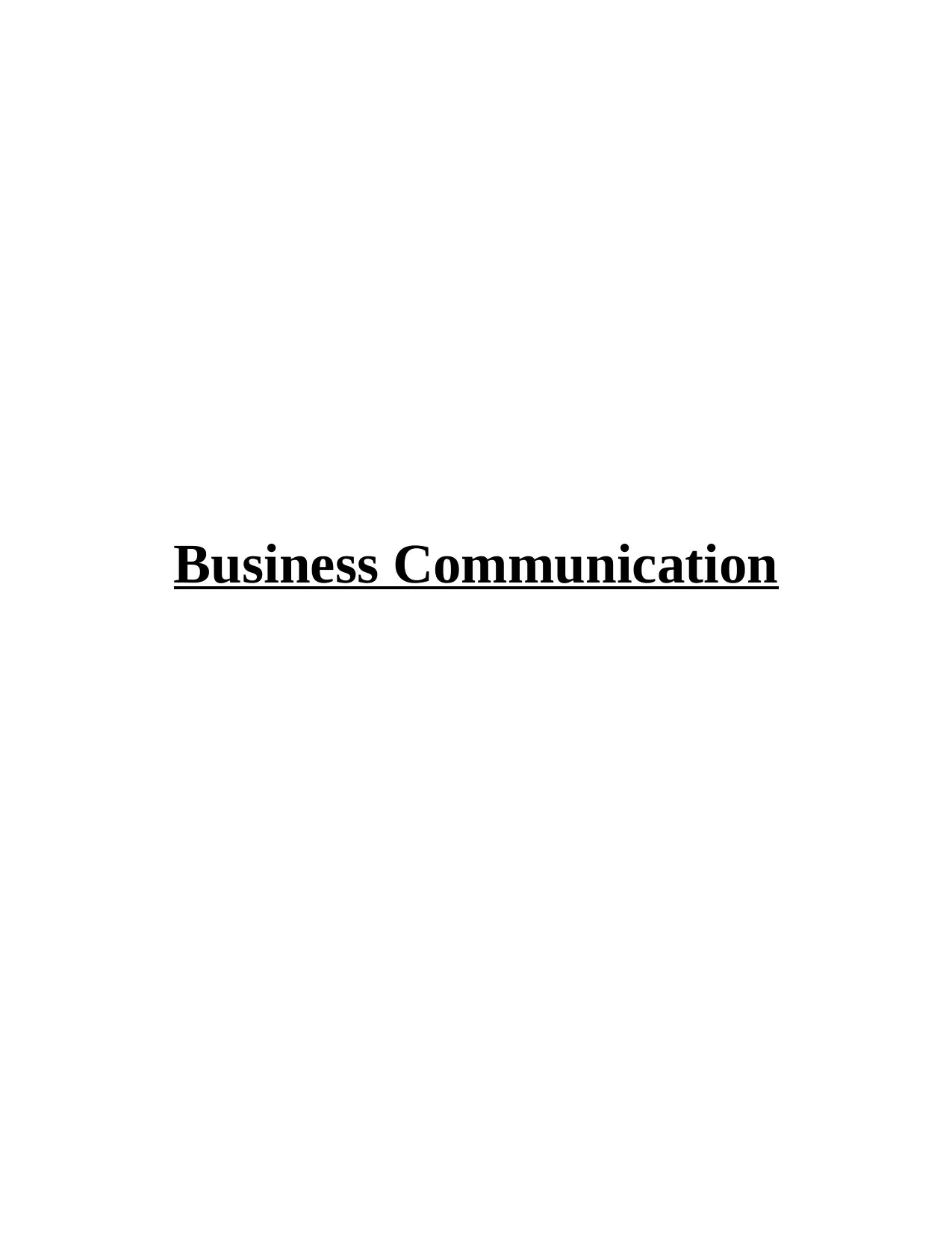
Business Communication
Paraphrase This Document
Need a fresh take? Get an instant paraphrase of this document with our AI Paraphraser
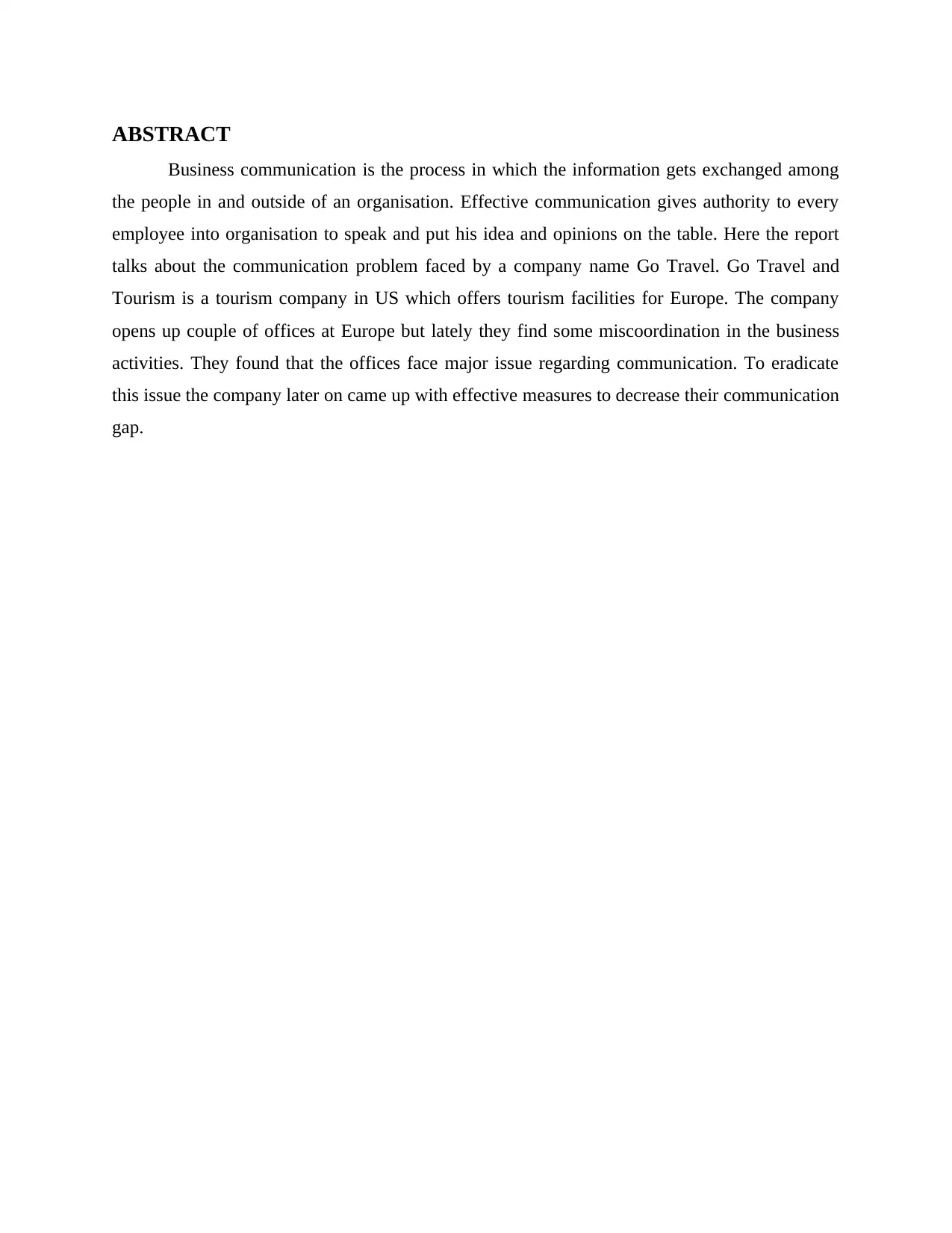
ABSTRACT
Business communication is the process in which the information gets exchanged among
the people in and outside of an organisation. Effective communication gives authority to every
employee into organisation to speak and put his idea and opinions on the table. Here the report
talks about the communication problem faced by a company name Go Travel. Go Travel and
Tourism is a tourism company in US which offers tourism facilities for Europe. The company
opens up couple of offices at Europe but lately they find some miscoordination in the business
activities. They found that the offices face major issue regarding communication. To eradicate
this issue the company later on came up with effective measures to decrease their communication
gap.
Business communication is the process in which the information gets exchanged among
the people in and outside of an organisation. Effective communication gives authority to every
employee into organisation to speak and put his idea and opinions on the table. Here the report
talks about the communication problem faced by a company name Go Travel. Go Travel and
Tourism is a tourism company in US which offers tourism facilities for Europe. The company
opens up couple of offices at Europe but lately they find some miscoordination in the business
activities. They found that the offices face major issue regarding communication. To eradicate
this issue the company later on came up with effective measures to decrease their communication
gap.
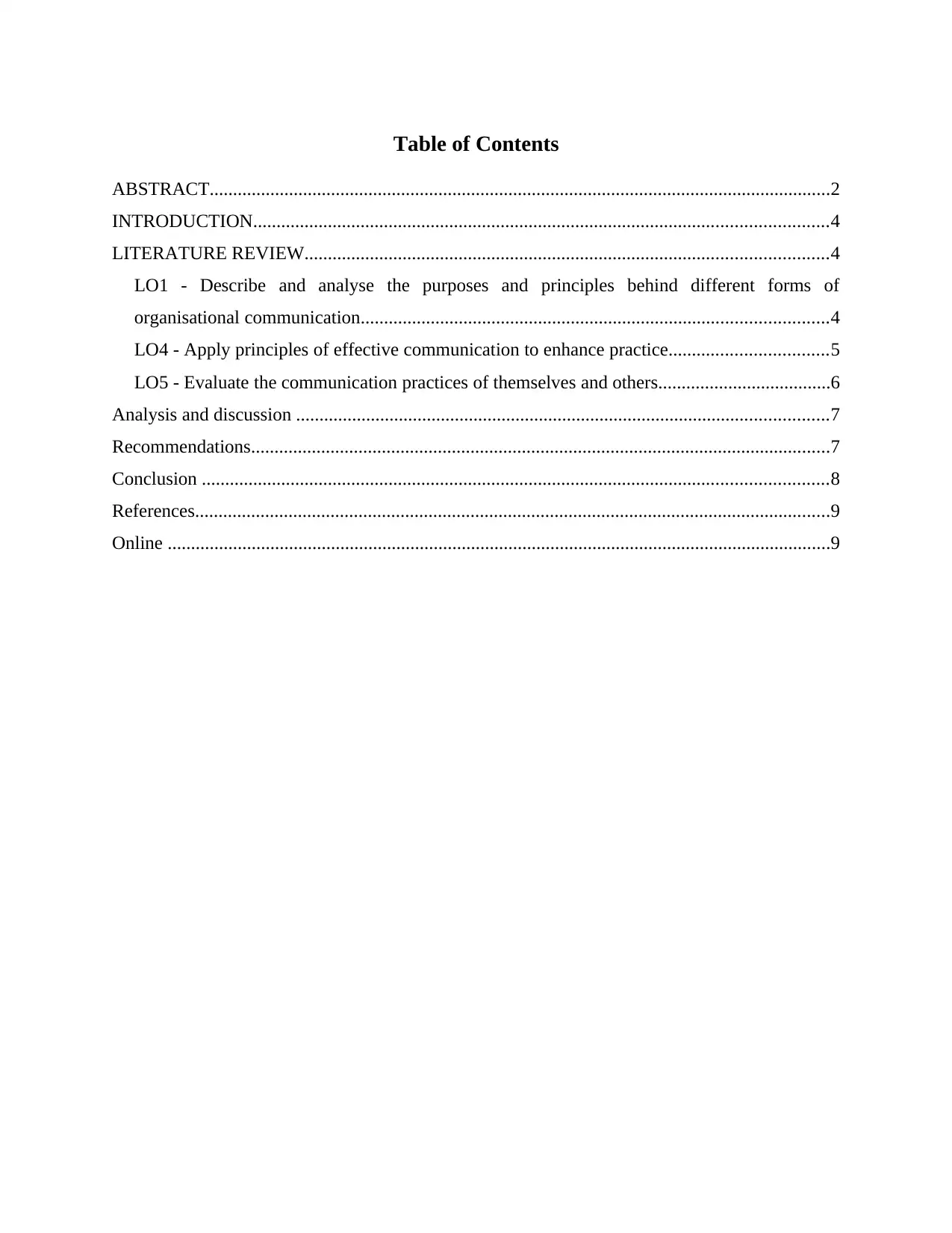
Table of Contents
ABSTRACT.....................................................................................................................................2
INTRODUCTION...........................................................................................................................4
LITERATURE REVIEW................................................................................................................4
LO1 - Describe and analyse the purposes and principles behind different forms of
organisational communication....................................................................................................4
LO4 - Apply principles of effective communication to enhance practice..................................5
LO5 - Evaluate the communication practices of themselves and others.....................................6
Analysis and discussion ..................................................................................................................7
Recommendations............................................................................................................................7
Conclusion ......................................................................................................................................8
References........................................................................................................................................9
Online ..............................................................................................................................................9
ABSTRACT.....................................................................................................................................2
INTRODUCTION...........................................................................................................................4
LITERATURE REVIEW................................................................................................................4
LO1 - Describe and analyse the purposes and principles behind different forms of
organisational communication....................................................................................................4
LO4 - Apply principles of effective communication to enhance practice..................................5
LO5 - Evaluate the communication practices of themselves and others.....................................6
Analysis and discussion ..................................................................................................................7
Recommendations............................................................................................................................7
Conclusion ......................................................................................................................................8
References........................................................................................................................................9
Online ..............................................................................................................................................9
⊘ This is a preview!⊘
Do you want full access?
Subscribe today to unlock all pages.

Trusted by 1+ million students worldwide
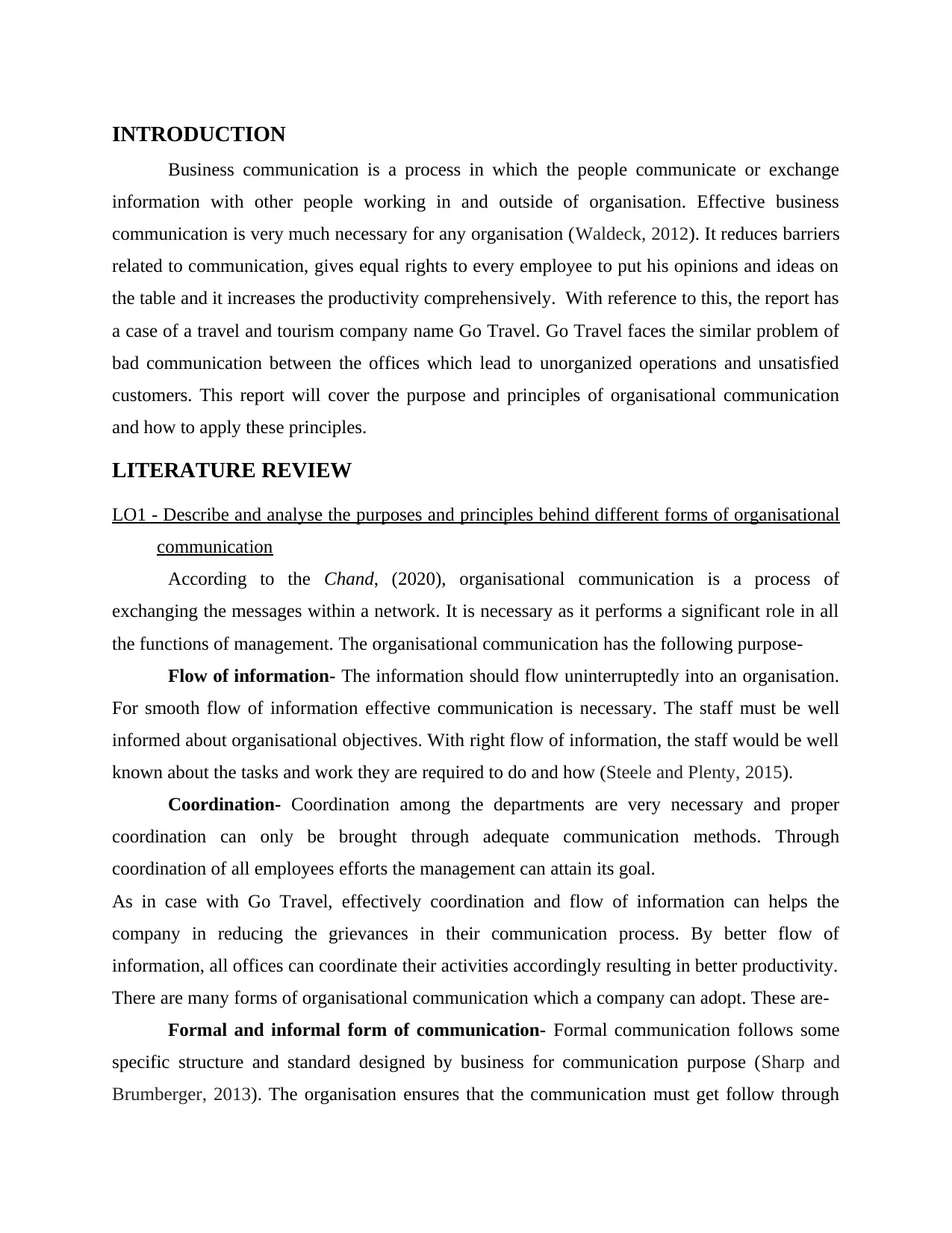
INTRODUCTION
Business communication is a process in which the people communicate or exchange
information with other people working in and outside of organisation. Effective business
communication is very much necessary for any organisation (Waldeck, 2012). It reduces barriers
related to communication, gives equal rights to every employee to put his opinions and ideas on
the table and it increases the productivity comprehensively. With reference to this, the report has
a case of a travel and tourism company name Go Travel. Go Travel faces the similar problem of
bad communication between the offices which lead to unorganized operations and unsatisfied
customers. This report will cover the purpose and principles of organisational communication
and how to apply these principles.
LITERATURE REVIEW
LO1 - Describe and analyse the purposes and principles behind different forms of organisational
communication
According to the Chand, (2020), organisational communication is a process of
exchanging the messages within a network. It is necessary as it performs a significant role in all
the functions of management. The organisational communication has the following purpose-
Flow of information- The information should flow uninterruptedly into an organisation.
For smooth flow of information effective communication is necessary. The staff must be well
informed about organisational objectives. With right flow of information, the staff would be well
known about the tasks and work they are required to do and how (Steele and Plenty, 2015).
Coordination- Coordination among the departments are very necessary and proper
coordination can only be brought through adequate communication methods. Through
coordination of all employees efforts the management can attain its goal.
As in case with Go Travel, effectively coordination and flow of information can helps the
company in reducing the grievances in their communication process. By better flow of
information, all offices can coordinate their activities accordingly resulting in better productivity.
There are many forms of organisational communication which a company can adopt. These are-
Formal and informal form of communication- Formal communication follows some
specific structure and standard designed by business for communication purpose (Sharp and
Brumberger, 2013). The organisation ensures that the communication must get follow through
Business communication is a process in which the people communicate or exchange
information with other people working in and outside of organisation. Effective business
communication is very much necessary for any organisation (Waldeck, 2012). It reduces barriers
related to communication, gives equal rights to every employee to put his opinions and ideas on
the table and it increases the productivity comprehensively. With reference to this, the report has
a case of a travel and tourism company name Go Travel. Go Travel faces the similar problem of
bad communication between the offices which lead to unorganized operations and unsatisfied
customers. This report will cover the purpose and principles of organisational communication
and how to apply these principles.
LITERATURE REVIEW
LO1 - Describe and analyse the purposes and principles behind different forms of organisational
communication
According to the Chand, (2020), organisational communication is a process of
exchanging the messages within a network. It is necessary as it performs a significant role in all
the functions of management. The organisational communication has the following purpose-
Flow of information- The information should flow uninterruptedly into an organisation.
For smooth flow of information effective communication is necessary. The staff must be well
informed about organisational objectives. With right flow of information, the staff would be well
known about the tasks and work they are required to do and how (Steele and Plenty, 2015).
Coordination- Coordination among the departments are very necessary and proper
coordination can only be brought through adequate communication methods. Through
coordination of all employees efforts the management can attain its goal.
As in case with Go Travel, effectively coordination and flow of information can helps the
company in reducing the grievances in their communication process. By better flow of
information, all offices can coordinate their activities accordingly resulting in better productivity.
There are many forms of organisational communication which a company can adopt. These are-
Formal and informal form of communication- Formal communication follows some
specific structure and standard designed by business for communication purpose (Sharp and
Brumberger, 2013). The organisation ensures that the communication must get follow through
Paraphrase This Document
Need a fresh take? Get an instant paraphrase of this document with our AI Paraphraser
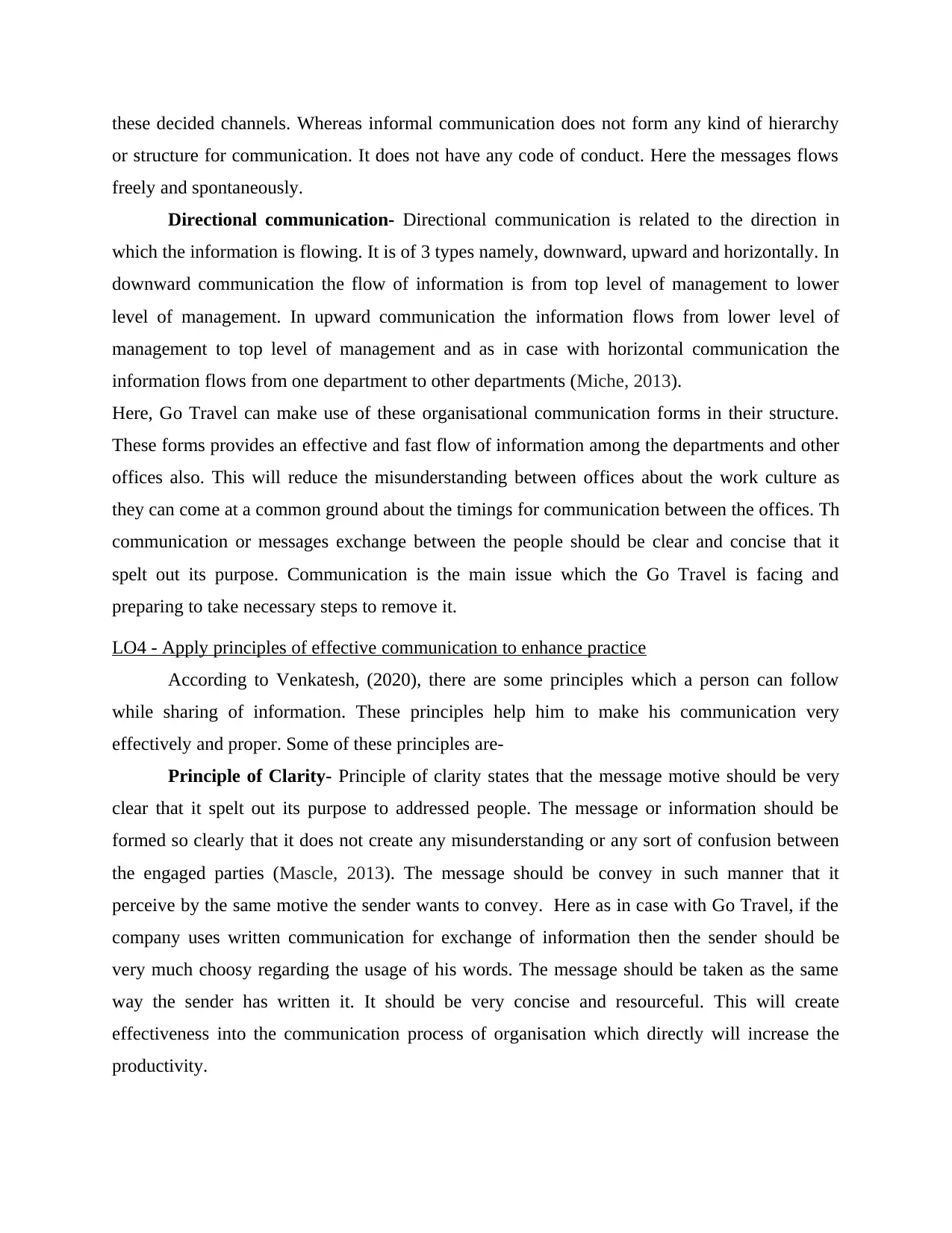
these decided channels. Whereas informal communication does not form any kind of hierarchy
or structure for communication. It does not have any code of conduct. Here the messages flows
freely and spontaneously.
Directional communication- Directional communication is related to the direction in
which the information is flowing. It is of 3 types namely, downward, upward and horizontally. In
downward communication the flow of information is from top level of management to lower
level of management. In upward communication the information flows from lower level of
management to top level of management and as in case with horizontal communication the
information flows from one department to other departments (Miche, 2013).
Here, Go Travel can make use of these organisational communication forms in their structure.
These forms provides an effective and fast flow of information among the departments and other
offices also. This will reduce the misunderstanding between offices about the work culture as
they can come at a common ground about the timings for communication between the offices. Th
communication or messages exchange between the people should be clear and concise that it
spelt out its purpose. Communication is the main issue which the Go Travel is facing and
preparing to take necessary steps to remove it.
LO4 - Apply principles of effective communication to enhance practice
According to Venkatesh, (2020), there are some principles which a person can follow
while sharing of information. These principles help him to make his communication very
effectively and proper. Some of these principles are-
Principle of Clarity- Principle of clarity states that the message motive should be very
clear that it spelt out its purpose to addressed people. The message or information should be
formed so clearly that it does not create any misunderstanding or any sort of confusion between
the engaged parties (Mascle, 2013). The message should be convey in such manner that it
perceive by the same motive the sender wants to convey. Here as in case with Go Travel, if the
company uses written communication for exchange of information then the sender should be
very much choosy regarding the usage of his words. The message should be taken as the same
way the sender has written it. It should be very concise and resourceful. This will create
effectiveness into the communication process of organisation which directly will increase the
productivity.
or structure for communication. It does not have any code of conduct. Here the messages flows
freely and spontaneously.
Directional communication- Directional communication is related to the direction in
which the information is flowing. It is of 3 types namely, downward, upward and horizontally. In
downward communication the flow of information is from top level of management to lower
level of management. In upward communication the information flows from lower level of
management to top level of management and as in case with horizontal communication the
information flows from one department to other departments (Miche, 2013).
Here, Go Travel can make use of these organisational communication forms in their structure.
These forms provides an effective and fast flow of information among the departments and other
offices also. This will reduce the misunderstanding between offices about the work culture as
they can come at a common ground about the timings for communication between the offices. Th
communication or messages exchange between the people should be clear and concise that it
spelt out its purpose. Communication is the main issue which the Go Travel is facing and
preparing to take necessary steps to remove it.
LO4 - Apply principles of effective communication to enhance practice
According to Venkatesh, (2020), there are some principles which a person can follow
while sharing of information. These principles help him to make his communication very
effectively and proper. Some of these principles are-
Principle of Clarity- Principle of clarity states that the message motive should be very
clear that it spelt out its purpose to addressed people. The message or information should be
formed so clearly that it does not create any misunderstanding or any sort of confusion between
the engaged parties (Mascle, 2013). The message should be convey in such manner that it
perceive by the same motive the sender wants to convey. Here as in case with Go Travel, if the
company uses written communication for exchange of information then the sender should be
very much choosy regarding the usage of his words. The message should be taken as the same
way the sender has written it. It should be very concise and resourceful. This will create
effectiveness into the communication process of organisation which directly will increase the
productivity.
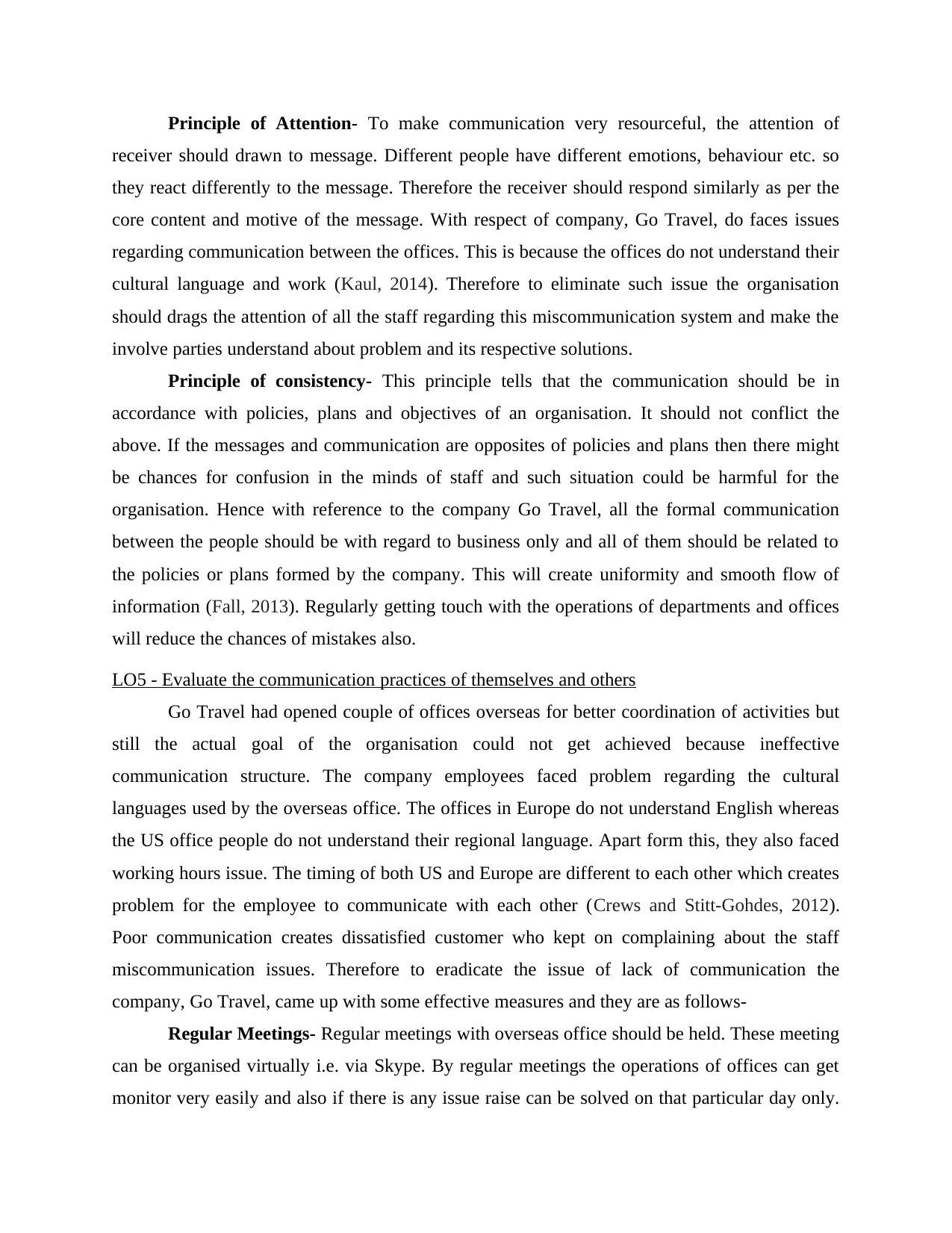
Principle of Attention- To make communication very resourceful, the attention of
receiver should drawn to message. Different people have different emotions, behaviour etc. so
they react differently to the message. Therefore the receiver should respond similarly as per the
core content and motive of the message. With respect of company, Go Travel, do faces issues
regarding communication between the offices. This is because the offices do not understand their
cultural language and work (Kaul, 2014). Therefore to eliminate such issue the organisation
should drags the attention of all the staff regarding this miscommunication system and make the
involve parties understand about problem and its respective solutions.
Principle of consistency- This principle tells that the communication should be in
accordance with policies, plans and objectives of an organisation. It should not conflict the
above. If the messages and communication are opposites of policies and plans then there might
be chances for confusion in the minds of staff and such situation could be harmful for the
organisation. Hence with reference to the company Go Travel, all the formal communication
between the people should be with regard to business only and all of them should be related to
the policies or plans formed by the company. This will create uniformity and smooth flow of
information (Fall, 2013). Regularly getting touch with the operations of departments and offices
will reduce the chances of mistakes also.
LO5 - Evaluate the communication practices of themselves and others
Go Travel had opened couple of offices overseas for better coordination of activities but
still the actual goal of the organisation could not get achieved because ineffective
communication structure. The company employees faced problem regarding the cultural
languages used by the overseas office. The offices in Europe do not understand English whereas
the US office people do not understand their regional language. Apart form this, they also faced
working hours issue. The timing of both US and Europe are different to each other which creates
problem for the employee to communicate with each other (Crews and Stitt-Gohdes, 2012).
Poor communication creates dissatisfied customer who kept on complaining about the staff
miscommunication issues. Therefore to eradicate the issue of lack of communication the
company, Go Travel, came up with some effective measures and they are as follows-
Regular Meetings- Regular meetings with overseas office should be held. These meeting
can be organised virtually i.e. via Skype. By regular meetings the operations of offices can get
monitor very easily and also if there is any issue raise can be solved on that particular day only.
receiver should drawn to message. Different people have different emotions, behaviour etc. so
they react differently to the message. Therefore the receiver should respond similarly as per the
core content and motive of the message. With respect of company, Go Travel, do faces issues
regarding communication between the offices. This is because the offices do not understand their
cultural language and work (Kaul, 2014). Therefore to eliminate such issue the organisation
should drags the attention of all the staff regarding this miscommunication system and make the
involve parties understand about problem and its respective solutions.
Principle of consistency- This principle tells that the communication should be in
accordance with policies, plans and objectives of an organisation. It should not conflict the
above. If the messages and communication are opposites of policies and plans then there might
be chances for confusion in the minds of staff and such situation could be harmful for the
organisation. Hence with reference to the company Go Travel, all the formal communication
between the people should be with regard to business only and all of them should be related to
the policies or plans formed by the company. This will create uniformity and smooth flow of
information (Fall, 2013). Regularly getting touch with the operations of departments and offices
will reduce the chances of mistakes also.
LO5 - Evaluate the communication practices of themselves and others
Go Travel had opened couple of offices overseas for better coordination of activities but
still the actual goal of the organisation could not get achieved because ineffective
communication structure. The company employees faced problem regarding the cultural
languages used by the overseas office. The offices in Europe do not understand English whereas
the US office people do not understand their regional language. Apart form this, they also faced
working hours issue. The timing of both US and Europe are different to each other which creates
problem for the employee to communicate with each other (Crews and Stitt-Gohdes, 2012).
Poor communication creates dissatisfied customer who kept on complaining about the staff
miscommunication issues. Therefore to eradicate the issue of lack of communication the
company, Go Travel, came up with some effective measures and they are as follows-
Regular Meetings- Regular meetings with overseas office should be held. These meeting
can be organised virtually i.e. via Skype. By regular meetings the operations of offices can get
monitor very easily and also if there is any issue raise can be solved on that particular day only.
⊘ This is a preview!⊘
Do you want full access?
Subscribe today to unlock all pages.

Trusted by 1+ million students worldwide
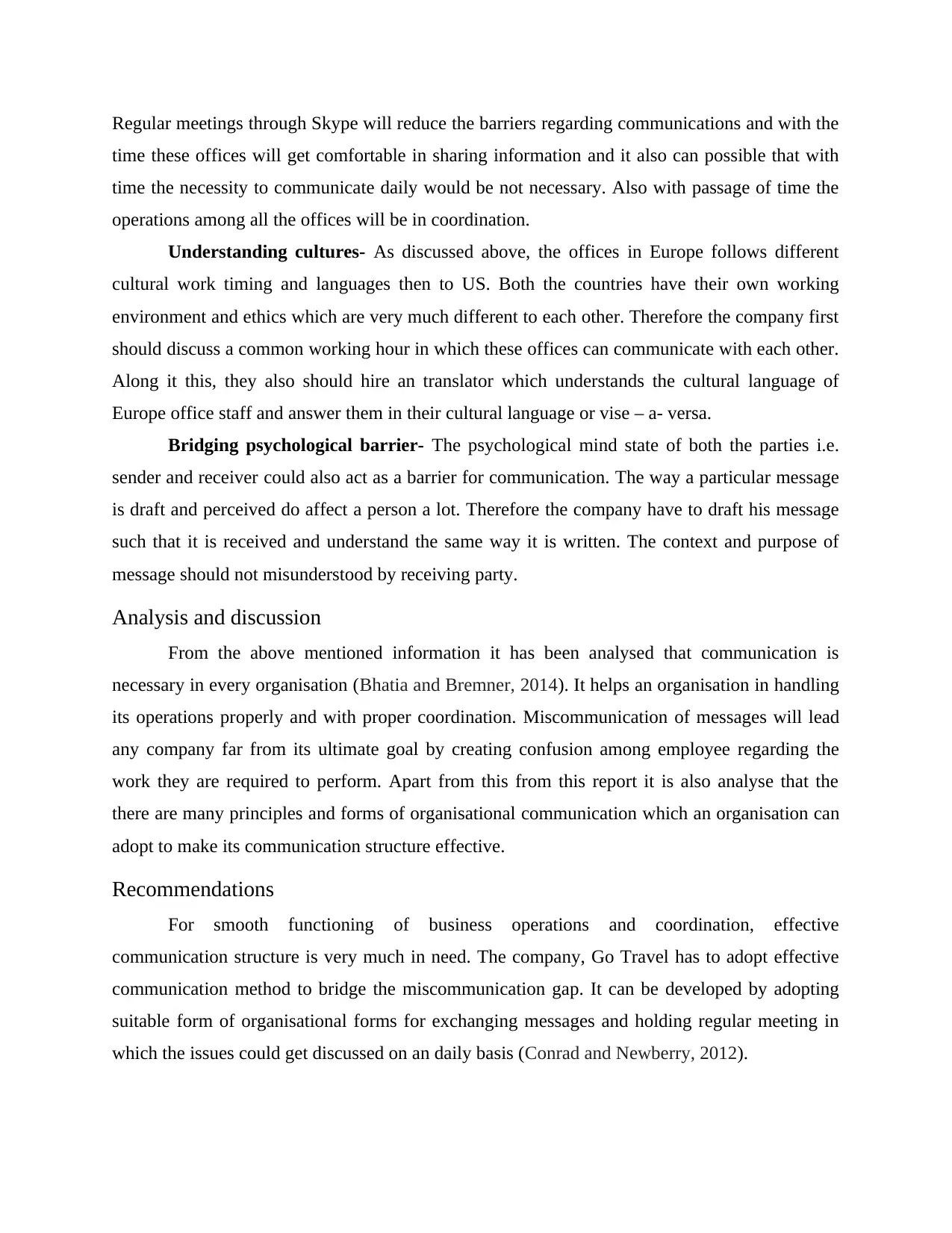
Regular meetings through Skype will reduce the barriers regarding communications and with the
time these offices will get comfortable in sharing information and it also can possible that with
time the necessity to communicate daily would be not necessary. Also with passage of time the
operations among all the offices will be in coordination.
Understanding cultures- As discussed above, the offices in Europe follows different
cultural work timing and languages then to US. Both the countries have their own working
environment and ethics which are very much different to each other. Therefore the company first
should discuss a common working hour in which these offices can communicate with each other.
Along it this, they also should hire an translator which understands the cultural language of
Europe office staff and answer them in their cultural language or vise – a- versa.
Bridging psychological barrier- The psychological mind state of both the parties i.e.
sender and receiver could also act as a barrier for communication. The way a particular message
is draft and perceived do affect a person a lot. Therefore the company have to draft his message
such that it is received and understand the same way it is written. The context and purpose of
message should not misunderstood by receiving party.
Analysis and discussion
From the above mentioned information it has been analysed that communication is
necessary in every organisation (Bhatia and Bremner, 2014). It helps an organisation in handling
its operations properly and with proper coordination. Miscommunication of messages will lead
any company far from its ultimate goal by creating confusion among employee regarding the
work they are required to perform. Apart from this from this report it is also analyse that the
there are many principles and forms of organisational communication which an organisation can
adopt to make its communication structure effective.
Recommendations
For smooth functioning of business operations and coordination, effective
communication structure is very much in need. The company, Go Travel has to adopt effective
communication method to bridge the miscommunication gap. It can be developed by adopting
suitable form of organisational forms for exchanging messages and holding regular meeting in
which the issues could get discussed on an daily basis (Conrad and Newberry, 2012).
time these offices will get comfortable in sharing information and it also can possible that with
time the necessity to communicate daily would be not necessary. Also with passage of time the
operations among all the offices will be in coordination.
Understanding cultures- As discussed above, the offices in Europe follows different
cultural work timing and languages then to US. Both the countries have their own working
environment and ethics which are very much different to each other. Therefore the company first
should discuss a common working hour in which these offices can communicate with each other.
Along it this, they also should hire an translator which understands the cultural language of
Europe office staff and answer them in their cultural language or vise – a- versa.
Bridging psychological barrier- The psychological mind state of both the parties i.e.
sender and receiver could also act as a barrier for communication. The way a particular message
is draft and perceived do affect a person a lot. Therefore the company have to draft his message
such that it is received and understand the same way it is written. The context and purpose of
message should not misunderstood by receiving party.
Analysis and discussion
From the above mentioned information it has been analysed that communication is
necessary in every organisation (Bhatia and Bremner, 2014). It helps an organisation in handling
its operations properly and with proper coordination. Miscommunication of messages will lead
any company far from its ultimate goal by creating confusion among employee regarding the
work they are required to perform. Apart from this from this report it is also analyse that the
there are many principles and forms of organisational communication which an organisation can
adopt to make its communication structure effective.
Recommendations
For smooth functioning of business operations and coordination, effective
communication structure is very much in need. The company, Go Travel has to adopt effective
communication method to bridge the miscommunication gap. It can be developed by adopting
suitable form of organisational forms for exchanging messages and holding regular meeting in
which the issues could get discussed on an daily basis (Conrad and Newberry, 2012).
Paraphrase This Document
Need a fresh take? Get an instant paraphrase of this document with our AI Paraphraser
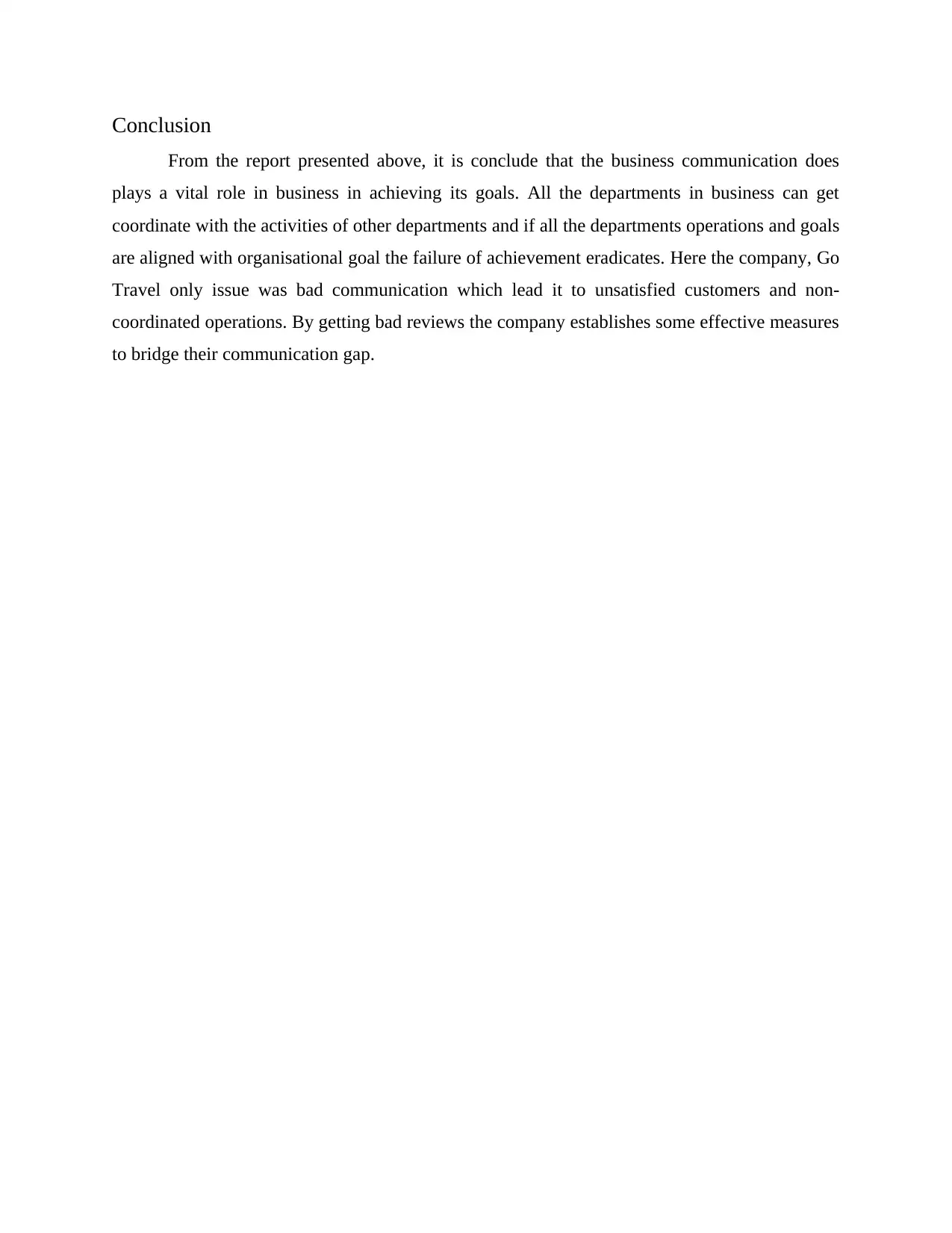
Conclusion
From the report presented above, it is conclude that the business communication does
plays a vital role in business in achieving its goals. All the departments in business can get
coordinate with the activities of other departments and if all the departments operations and goals
are aligned with organisational goal the failure of achievement eradicates. Here the company, Go
Travel only issue was bad communication which lead it to unsatisfied customers and non-
coordinated operations. By getting bad reviews the company establishes some effective measures
to bridge their communication gap.
From the report presented above, it is conclude that the business communication does
plays a vital role in business in achieving its goals. All the departments in business can get
coordinate with the activities of other departments and if all the departments operations and goals
are aligned with organisational goal the failure of achievement eradicates. Here the company, Go
Travel only issue was bad communication which lead it to unsatisfied customers and non-
coordinated operations. By getting bad reviews the company establishes some effective measures
to bridge their communication gap.
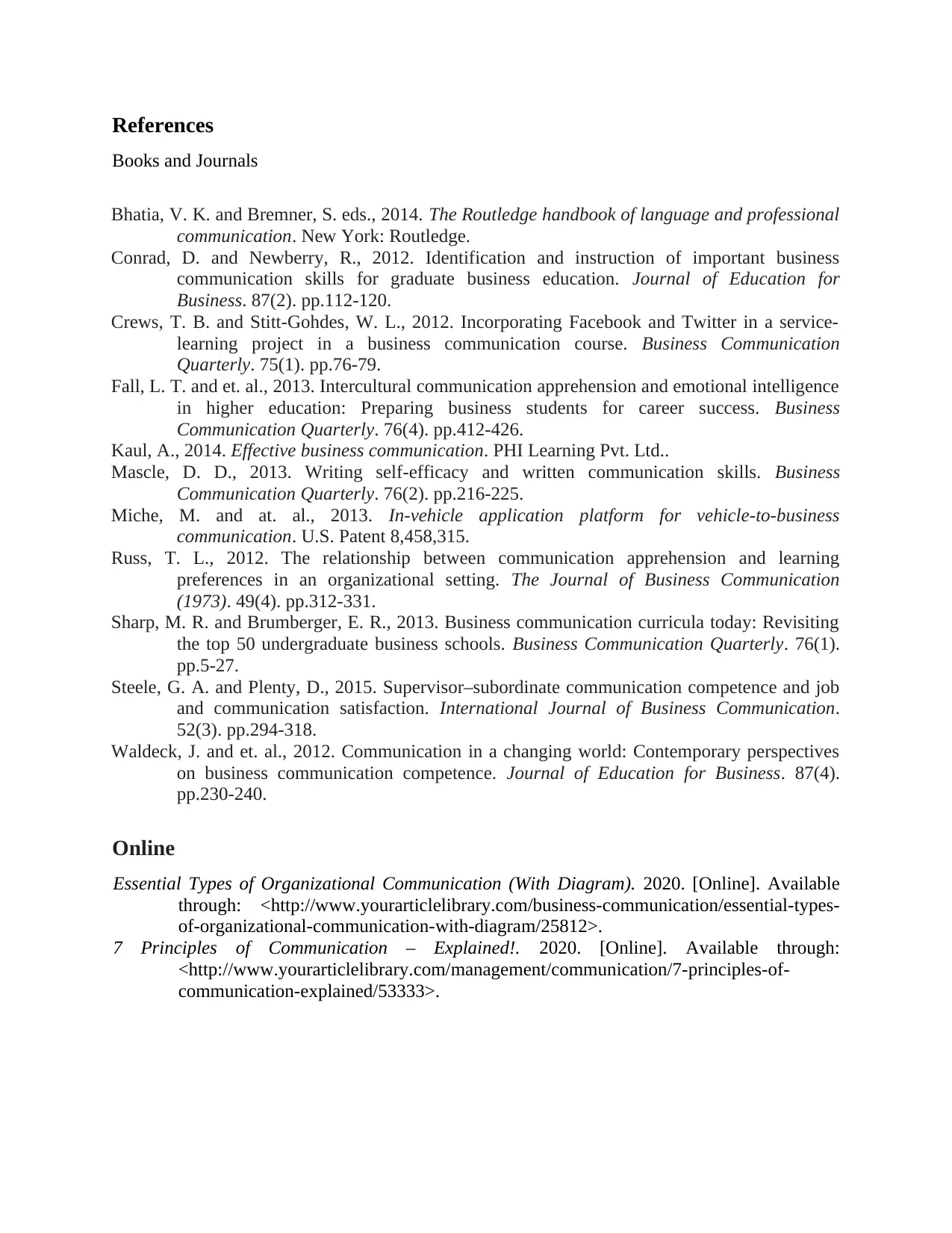
References
Books and Journals
Bhatia, V. K. and Bremner, S. eds., 2014. The Routledge handbook of language and professional
communication. New York: Routledge.
Conrad, D. and Newberry, R., 2012. Identification and instruction of important business
communication skills for graduate business education. Journal of Education for
Business. 87(2). pp.112-120.
Crews, T. B. and Stitt-Gohdes, W. L., 2012. Incorporating Facebook and Twitter in a service-
learning project in a business communication course. Business Communication
Quarterly. 75(1). pp.76-79.
Fall, L. T. and et. al., 2013. Intercultural communication apprehension and emotional intelligence
in higher education: Preparing business students for career success. Business
Communication Quarterly. 76(4). pp.412-426.
Kaul, A., 2014. Effective business communication. PHI Learning Pvt. Ltd..
Mascle, D. D., 2013. Writing self-efficacy and written communication skills. Business
Communication Quarterly. 76(2). pp.216-225.
Miche, M. and at. al., 2013. In-vehicle application platform for vehicle-to-business
communication. U.S. Patent 8,458,315.
Russ, T. L., 2012. The relationship between communication apprehension and learning
preferences in an organizational setting. The Journal of Business Communication
(1973). 49(4). pp.312-331.
Sharp, M. R. and Brumberger, E. R., 2013. Business communication curricula today: Revisiting
the top 50 undergraduate business schools. Business Communication Quarterly. 76(1).
pp.5-27.
Steele, G. A. and Plenty, D., 2015. Supervisor–subordinate communication competence and job
and communication satisfaction. International Journal of Business Communication.
52(3). pp.294-318.
Waldeck, J. and et. al., 2012. Communication in a changing world: Contemporary perspectives
on business communication competence. Journal of Education for Business. 87(4).
pp.230-240.
Online
Essential Types of Organizational Communication (With Diagram). 2020. [Online]. Available
through: <http://www.yourarticlelibrary.com/business-communication/essential-types-
of-organizational-communication-with-diagram/25812>.
7 Principles of Communication – Explained!. 2020. [Online]. Available through:
<http://www.yourarticlelibrary.com/management/communication/7-principles-of-
communication-explained/53333>.
Books and Journals
Bhatia, V. K. and Bremner, S. eds., 2014. The Routledge handbook of language and professional
communication. New York: Routledge.
Conrad, D. and Newberry, R., 2012. Identification and instruction of important business
communication skills for graduate business education. Journal of Education for
Business. 87(2). pp.112-120.
Crews, T. B. and Stitt-Gohdes, W. L., 2012. Incorporating Facebook and Twitter in a service-
learning project in a business communication course. Business Communication
Quarterly. 75(1). pp.76-79.
Fall, L. T. and et. al., 2013. Intercultural communication apprehension and emotional intelligence
in higher education: Preparing business students for career success. Business
Communication Quarterly. 76(4). pp.412-426.
Kaul, A., 2014. Effective business communication. PHI Learning Pvt. Ltd..
Mascle, D. D., 2013. Writing self-efficacy and written communication skills. Business
Communication Quarterly. 76(2). pp.216-225.
Miche, M. and at. al., 2013. In-vehicle application platform for vehicle-to-business
communication. U.S. Patent 8,458,315.
Russ, T. L., 2012. The relationship between communication apprehension and learning
preferences in an organizational setting. The Journal of Business Communication
(1973). 49(4). pp.312-331.
Sharp, M. R. and Brumberger, E. R., 2013. Business communication curricula today: Revisiting
the top 50 undergraduate business schools. Business Communication Quarterly. 76(1).
pp.5-27.
Steele, G. A. and Plenty, D., 2015. Supervisor–subordinate communication competence and job
and communication satisfaction. International Journal of Business Communication.
52(3). pp.294-318.
Waldeck, J. and et. al., 2012. Communication in a changing world: Contemporary perspectives
on business communication competence. Journal of Education for Business. 87(4).
pp.230-240.
Online
Essential Types of Organizational Communication (With Diagram). 2020. [Online]. Available
through: <http://www.yourarticlelibrary.com/business-communication/essential-types-
of-organizational-communication-with-diagram/25812>.
7 Principles of Communication – Explained!. 2020. [Online]. Available through:
<http://www.yourarticlelibrary.com/management/communication/7-principles-of-
communication-explained/53333>.
⊘ This is a preview!⊘
Do you want full access?
Subscribe today to unlock all pages.

Trusted by 1+ million students worldwide

1 out of 10
Related Documents
Your All-in-One AI-Powered Toolkit for Academic Success.
+13062052269
info@desklib.com
Available 24*7 on WhatsApp / Email
![[object Object]](/_next/static/media/star-bottom.7253800d.svg)
Unlock your academic potential
Copyright © 2020–2025 A2Z Services. All Rights Reserved. Developed and managed by ZUCOL.




